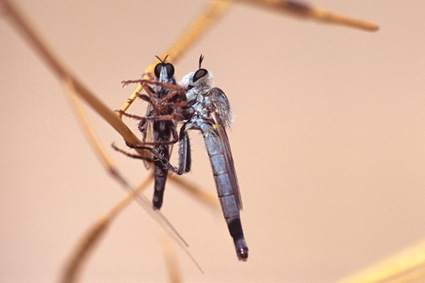Stenopogoninae sensu Dikow 2009a

Scleropogon duncani , image © Torsten Dikow.
Stenopogoninae
– facial swelling and mystax extending over lower facial half (4, 7)
– postmentum ventrally with median groove in distal part (19)
– all ommatidia same size (46)
– postpedicel cylindrical throughout (54)
– setae on anteroventral prothoracic tibiae absent (105)
– female spermathecal reservoir formed by more or less expanded and coiled ducts (180)
Stenopogoninae sensu previous authors has been suspected to be non-monophyletic and used to be the largest taxon of Asilidae containing 118 genera (Geller-Grimm 2004) of which 37 are included in Dikow (2009). It was divided into 10 subordinate taxa to accommodate this diversity in a meaningful way by previous authors. In the new delimitation of Stenopogoninae, only three of the subordinate taxa are recognised by Dikow (2009) and the remaining taxa are either placed as a higher-level taxon, i.e., Bathypogoninae, Phellinae, Tillobromatinae, and Willistonininae, or transferred to another higher-level taxon, i.e., Acronychini to Leptogastrinae, Ceraturgini and Cyrtopogonini to Brachyrhopalinae.
Enigmomorphini: Connomyia, Creolestes, Daspletis, Microstylum, Prolepsis
– maxillary stipites fused medially, but V-shaped indentation present (14)
– maxillae proximally high and distal tip distinctly narrower (28)
– regular setae form discal scutellar setae (99)
– female spermathecae occupying at most three posterior segments (182)
The Enigmomorphini was originally described by Hull (1962) to accommodate the Neotropical genus Enigmomorphus, and later expanded by Artigas & Papavero (1991) to include 14 genera. The New World genus Archilestris is transferred to the Dasypogoninae and the two Afrotropical genera Connomyia and Daspletis are transferred here to Enigmomorphini.
Plesiommatini: Plesiomma
– vertex between compound eyes sharply depressed (3)
– facial swelling extending over entire face (4)
– mystax restricted to lower facial margin (7)
– dorsal flange medially on prementum absent (22)
– hypopharynx seta-like spicules spaced far apart (33)
– pharyngeal pump with entire sclerotised ring on lateral margin and circular in shape (40, 41)
– anterior tentorial pits well developed and conspicuous anteromedially located (44)
– frons at antennal insertion markedly approximating medially at level of antennal insertion (48)
– regular setae on lateral margin of frons dorsal to antennal insertion (no macrosetae) (49)
– regular setae forming postpronotum setae (no macrosetae) (70)
– scutellum small and mesopostnotum visible in dorsal view (97)
– apical scutellar setae absent (98)
– regular setae forming setation on ventral metathoracic femora (116)
– T2 longer than wide, but less than twice as long (153)
– female common spermathecal duct long, extending beyond tip of furca (177)
– male lateral ejaculatory process present and formed by a large cylindrical sclerite (213)
The Plesiommatini was described by Artigas & Papavero (1991) to accommodate the three Neotropical genera Cystoprosopa, Dapsilochaetus, and Plesiomma.
Stenopogonini: Gonioscelis, Ospriocerus, Scleropogon, Stenopogon
– head circular, as wide as high, in anterior view (1)
– maxillary stipites divided medially (14)
– ventral margin of postmentum entirely smooth (19)
– dorsoposterior margin of cibarium with only one ridge connecting cornua and cornua not originating from ridge (35)
– cornua developed in anteroposterior orientation (37)
– prosternum and proepisternum separated and prosternum triangular with pointed dorsal tip (74)
– cell m3 closed (135)
– R2+3 apex arching sharply anteriorly in 90 degrees angle (142)
– male hypopygium not rotated (195)
The Stenopogonini has been restricted by Dikow (2009) to only those robber flies with a circular head and with the character combination mentioned above.
Genera not placed within above tribal taxa:
